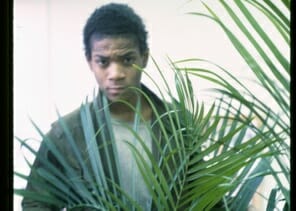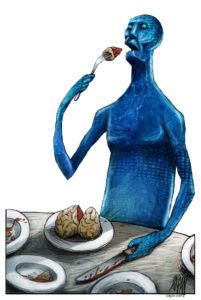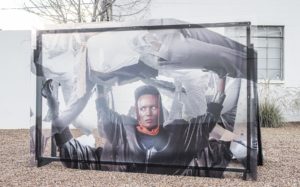Filmmaker Sara Driver on Jean-Michel Basquiat (Audio and Transcript)
Truthdig Editor in Chief Robert Scheer discusses the American artist with the director of a film titled “Boom for Real: The Late Teenage Years of Jean-Michel Basquiat." Image via KCRW
Image via KCRW
Listen to the interview in the player above and read the transcript below. Find past episodes of “Scheer Intelligence” here.
–posted by Emily Wells
Full transcript:
Robert Scheer: Well, hello. This is another edition of Scheer Intelligence, where the intelligence comes from my guests. In this case, Sara Driver, the director of a movie that’s getting a lot of interesting and favorable criticism and reviews. It’s called Boom for Real: The Late Teenage Years of Jean-Michel Basquiat. You know, I remember that period; actually, I remember being in New York at that time, East Village life. And as you describe it in the film, the city was decaying; we’re talking about–well, his life was from 1960 to ‘87, I guess. And why did you pick the teenage years? And it sort of makes a statement about New York and the emerging art scene.
Sara Driver: My friend Alexis Adler, who lived with Jean-Michel from 1979 to 1980, and while she was studying at Rockefeller University, she was studying tropical diseases, she looked through a microscope for 30 years. And after Jean left her, you know, left living with her, she put away all this work that he’d left behind, that he had given her. And when Sandy, Hurricane Sandy, hit the Lower East Side and flooded the Lower East Side, she suddenly remembered she had all this work that she had put away. And it was in a bank vault underground, so she was quite worried about it. And then she went and looked in the bank box, and she had 60 works of his, including notebooks, writings, drawings. And then she remembered she had put away a box of clothes that he had painted, and she also rediscovered about 150 photographs she had taken of him while he lived with her. I went over to her house, just right after Sandy hit, and right after she rediscovered all these things. And I saw everything that she had, and I just thought, when I saw it–wow, this is such an insight into him as a developing artist, and also a window into our city at that time. There’s very little work of his, there’s smatterings of it among friends, but there’s very little work of his at that time, because he was so transient. But she really kept a wonderful archive that really gives clues into his later paintings and his thought process.
RS: Probably most people listening to this know a great deal about Jean-Michel Basquiat, because, if for no other reason than that last May, last year, a painting of his set the record of all time, $110 million and change. And I gather that’s the most expensive painting for an American artist ever?
SD: I think for any artist ever.
RS: Yeah, any artist. And it’s a skull, and it was bought by a Japanese entrepreneur, who made his money with sort of internet applications and so forth. And he’s going to open a museum outside Tokyo and have it there. And it just raised the question, because he’s described as a rebellious artist, somebody who came out of street art, associated with various musical movements as well as artistic at the time. And your documentary I found fascinating because it really raises the question of whether he was a rebel, or whether this was a kid, you know, from a family that was breaking up, a Haitian family where he wanted in, he wanted to be in on the hottest scene. And it’s really a question whether he was a rebel, or he was somebody who actually was desperate to get into this commodity culture that he often decried.
SD: Well, I think he was a very driven artist; that’s clear, he was incredibly prolific in the short amount of time that he lived. And what I learned making the film, I mean, I knew he was a great wordsmith, but I really realized that by the age of about 18, he was an advanced poet already. His use of words are phenomenal, and I think that also makes his paintings so special.
RS: And he was fluent in three languages, right? And so he had French, Spanish, English. And I’m just trying to capture, I mean, for people who haven’t yet seen the movie, and they should go and watch it all, it seems to me there’s a tension in the film. There’s no question he’s a prolific artist, there’s no question he’s brimming with all sorts of ideas. But it seems to me the film poses or begs the question, what was his rebellion about? Was it trying to get in, be successful, be accepted? Or was it to make all sorts of contrarian political statements and challenge the status quo?
SD: Well, I think I was trying to show in the film the environment that nurtured him. Because a lot of the artists that were working then, that were around and in the Lower East Side, were politically active, and activists. You know, taking over abandoned buildings and doing shows in them, and really, you know, declaring themselves their own art galleries and things like that, being that they weren’t accepted by the established art world. I mean, Jean Michel was very calculating in that he did Samos only in the area where there were art galleries. And I use in the poster a picture that Al Diaz, who was his partner in SAMO, where he’s wearing a beret, and I said to Al, I said, well, does he think, is he trying to be Che Guevara with that beret on his head? And Al started laughing and he said, no, that’s what Jean Michel thought that an artist looked like.
RS: For people who don’t know, Samos was the graffiti message, basically, right, “SAMO,” that suddenly appeared in these neighborhoods and had sort of provocative content, raised questions. And then at some point they just stopped it, the two of them, they had a falling out, moved on to other things.
SD: Well, Jean Michel took, you know, when there was the, after the article in the Village Voice, which exposed SAMO, he took that on as his own. You know, was not good to Al. But many years later, Al told me that he was in his tenement apartment and the doorbell rang, and he looked down, and there was Jean Michel with a triptych painting. And he was looking up at Al, and he had this painting for Al, and it said “From SAMO to SAMO.” So Jean Michel was very aware that he was not correct with him.
RS: You know, this is a film that you obviously did with a great deal of understanding and love. What would you say the lesson, or the lessons, are from watching this? What does it tell us about art, artists, and this particular artist?
SD: Well, I think it was such, like a particular moment in time in New York City where there was this gathering of so many varied kinds of artists. We’re really lucky–Diego Cortez at one point said to me, I don’t have it in the film, but he said: It was like Paris at the turn of the century, or Berlin in the twenties. This meeting of so many people, so many young people from all over the country who were experimenting with so many different forms. And so it was very exciting, because art–all kinds of art needs other art to nurture it, and I think that we all germinated each other, in a way. And Jean Michel himself was a musician, he was a poet, he was a painter, he was a sculptor. I’m sure, you know, he was also an actor; he produced this incredible record by the artist Rammellzee. And all of us were sort of trying things, and trying different forms, and failing at them, and succeeding. And I think now, young people, they feel a risk at failing. And you know, you have to fail in order to learn. And it’s very important, and not everything can be perfect. You know, we had a very like “Just pick up a guitar and play it,” you know, “Pick up a paintbrush and paint”; you know, just try things. And I think that spirit was really contagious for all of us. I remember going to see a show put together by Carlo McCormick, who’s also in the film. And he did a show of New York City, downtown New York 1974 to 1984. And that was the first time, because I was inside this world, it was the first time I saw, looking from outside, of how many of the arts did germinate each other. You know, and how rich it was in terms of performance art and music and all those things.
RS: Well, it was also a time when the Big Apple was a bit rotten, in appearance, right? There was enormous contradictions, you know, of the Bronx burning, of decay, urban decay, violence and so forth. And it’s not the polished, gentrified SoHo of now, or Lower East Side of now, of this time. And his art addressed that uglier contradiction. The graffiti, and then his art, had messages; they were enigmatic, but they were provocative. The real question I keep pushing here, and maybe it’s not the right question, but it seems to me that it’s in your movie, is, he was against the whole commodity fetish and the whole commercialization of everything. But he ends up apparently embracing it, and wanting to be part of it. And so the money is not an accident; he was actually open to marketing. I mean, there are plenty of street artists that die poor, but he didn’t; he seemed to be on a calculated path to a certain kind of material success, was he not?
SD: Everybody was very surprised by that, that this 18-year-old kid was so determined. And also like when Patricia Fields in the film talks about, you know, that his sculptures, he wanted $10,000 in 1979, you know [Laughs] None of us were really thinking about money, or that–you know, [inaudible] said to me, you know, if you could publish a poem in a magazine, that was the height of success. Because we didn’t need much money to live then, so we weren’t thinking in terms of money and making art for money; we were kind of making art for each other. And, but Jean was very unique in that. But I also find him as an artist to be almost like a profit, because his paintings are so relevant now. His subject matters are so relevant now, and so vibrant. You know, I think a lot of great artists have that kind of gift. You know, I always think of, like, J.G. Ballard as being almost a profit, or Burroughs, or people like that. And knowing his self-worth was incredible for a teenage, a guy in his late teens.
RS: OK. I’m going to drop this point after trying one last time. [Laughter] That’s OK, I may be totally off base here. But I got a sense that this was not just art for art’s sake, or art for its message; that this guy, whatever his other motives, also wanted to prove that he could make it, and he could make it like a Warhol made it, or others. That he was going to crack this market. And he was an unusual figure, which was mostly white people, right, of certain backgrounds. And he seemed quite determined to figure it out and then succeed at it. And at the end of your movie, one is not surprised that he ends up being an enormous financial success, and he has appeal to another group of people–you’re stressing the artists, and living on very little–but also, this is where the bankers started emerging in New York.
SD: Exactly.
RS: These people are throwing a lot of money around, and these wonderful avant-garde galleries are starting to make a lot of money selling to Wall Street types, right? And the ultimate sale, so far, anyway, of his work, to a, you know, a businessman from Tokyo, is a perfect example. This guy in interviews can hardly explain what he even likes about the painting, but it’s just prestigious to have it.
SD: Well, I think that’s also why I stopped my movie in 1980. You know, in ends in 1981. Because then the bankers started stepping in, and everything started changing. And you know, Jean didn’t, when he died at 27 years old, he didn’t have a whole lot. I mean, he didn’t own a house, he didn’t own a car; he had really nice clothes, he went on nice vacations, he drank good wine. But nothing like what his work is selling for today. You know, he did have a sense of how valuable he was, and he was a very hard worker. And I think you’re right, I think he wanted a certain acceptance, and to prove that he could do it. And he was extraordinary.
RS: You know, you were a witness to a critical time. It really sort of started in the postwar period. But where art becomes, a market is made in art, it becomes an incredible commodity, hustle, thing to game. And people who really don’t care very much about art suddenly get interested in it either for fun or profit; that you can buy this stuff, bet on who’s going to succeed; maybe game the system by having other friends, who write criticism for big newspapers or something, write about it. And you’re going to come out a winner, and you know, as I’ve gone around as a journalist and been in different people’s homes, they’re very proud of their acquisitions, particularly from that period. And you were a witness to that, right? And didn’t–I remember Thomas Wolfe’s book, The Painted Word; I mean, there was something that happened with the commercialization of all this, that the artists thought they were doing something very provocative and interesting, but it was really very expensive wallpaper for the customers, right?
SD: Well, you know, that happened, that’s what’s going on now, is that art is being treated as an investment. And it’s unfortunate, because a lot of great art is being bought and then put in warehouses. You know, as an investment. And they’re not being shown. What museum can afford a Basquiat, even? You know, when a Caravaggio can’t even sell for $3 million, and you’re selling a Basquiat for $110 million, there’s something strange, you know. [Laughs] You know, I almost think of this “art as an investment”–it’s almost like looking at musical instruments in a museum. You know, there’s a, there’s something very sad about it.
RS: So tell me about yourself and your connection with this movement, and how you got into it.
SD: I went to NYU film school, I started in 1978, going to the graduate film school, which was right in the epicenter of the Lower East Side; it was on 7th Street between 2nd and 3rd Avenues. And you know, we used to go to clubs and listen to music, and you know. And in order to make films, you have to sort of know all kinds of, you have to know art, you have to know music; because film is a combination of all those things. We were making our own little films for very little money, and I produced Jim Jarmusch’s first film, Permanent Vacation, and he told me, “I have no money, you have to get me locations for nothing.” And it was great, because in the city then, you could get locations for nothing, because there were no permits; there were none of this insurance that you need today. You could just go and grab shots places. You know, he sort of threw me into the cold water and just said, you know, OK, we’re going to make this film and just figure out how to do it. [Laughs] And that was pretty much our attitude; everybody’s attitude who was downtown was, we just sort of all jumped in the water and figured out how to do things. And then I made my first film in 1981, which was called You are Not I, which was based on a Paul Bowles story. And it was not about the New York, that scene at all, but involved a lot of people who were in that scene. You know, Nan Goldin is in the movie for a moment, and Suzanne Fletcher is the lead, and Phil Kline, who was in the Del-Byzanteens, does the music, and Luc Sante’s in it, and a lot of people that are still my friends today. It was just a very rich time, and it was also, the city was so dangerous that you had to watch each other’s backs. And you know, I remember my hair, in order to go to, because I’d go and edit at night at NYU, and so Jim actually cut my hair really short for me, so it was only an inch long, and I could look like a boy, and walk the streets at night and not be bothered. But it was also kind of wonderful, because you had to have such a tuned antenna to what was going on around you in the city, that you had gifts all the time; you were seeing these interactions between people, or between yourself and someone else. And I said to someone the other night, it was like we owned the city; it was like our city. We could work and play and paste up posters everywhere, and you know, announcing what we were doing, and it was pretty remarkable, because nobody else wanted to be in New York, it was very dangerous.
RS: That’s the key. Well, it wasn’t just New York; that particular neighborhood, now you go there and it’s the most gentrified section in New York. But back then–I grew up in New York myself, and I, you know, would go there quite often–you had freedom precisely because the swells [laughs] were elsewhere. And this was your playground. [Omission for station break] I’m trying to get some more, deeper grasp on this art world. Art now, I mean, OK, so very wealthy people can set up museums, set up collections, decide what’s in. And the reason I’m pushing this is that Jean Michel Basquiat is described as a very political artist. You know, in the way Picasso was a very political person; that he saw the contradictions in the society, he had a sense of what racism and colonialism does, right? That comes up a lot in descriptions. Let’s talk about that, and whether that got diluted, or whether that got coopted in the process.
SD: I think a horrible thing that happened, you know, was when Michael Stewart was killed, who was a good friend of his. Who was, you know, strangled by the NYPD in the subway station on 14th Street for doing graffiti. Of course, you know, Jean was very aware of racism, and you know, often at that time, you couldn’t get, if you were black, you couldn’t get a cab. You know, you couldn’t, it was just, it was a daily assault. I love his love of jazz, as well, and bebop particularly. I think that’s what also makes his work so relevant now, is because so many things that happened then are still happening. The society hasn’t improved. And also I was thinking about how so many things in the greater world are similar to what they were in ‘79. You know, we were back in the Cold War because Russia invaded Afghanistan, which we are in now. We had the beginning, we had our TV, our B-movie president who was elected, was Ronald Reagan, and now we have our reality TV president. There are many similarities. And I think he was responding to all that. I mean, one of my favorite graffitis of all time was “USA out of NYC.” You know, and I sort of feel like that now, like I wish New York would just become Luxembourg, and we could separate from the rest of the country. I’m sure you do in California, too. [Laughs]
RS: Well, that’s a great idea, but who gets Wall Street? [Laughter]
SD: Yeah, that’s right.
RS: But I do want to push this just a bit further. Because what you said is really quite profound and brave: the society, in a basic way, hasn’t improved. And there’s actually recent documentation for that. You know, 50 years ago we had the Kerner Commission report; that’s when Jean Michel Basquiat was eight years old, I guess, it was written. And now we’ve just had the rewrite of it by the Eisenhower institute, pretty much same kind of scholarly researchers. And they concluded–I mean, it was the Kerner Commission that reported on “separate and not equal” continuing despite court changes and segregation ending. And that this is, they conclude it’s the same now. And we see it in city after city, where the racial divide is very strong; we see it in the economic statistics, what happens to black income. Generally, income redistribution in the United States has stalled in any serious way. And you’re absolutely right; watching your documentary, and I want to repeat it so people will go watch it, Boom for Real: The Late Teenage Years of Jean Michel Basquiat, the issues raised by his work, by his art, are front and center now. Your documentary is unfortunately very accurate and timely in this period. Did that surprise you?
SD: No. I think, you know, I knew there was this enormous curiosity about where this young artist came from. And then when I saw Alexis’s work, I realized, these are the clues to inform, particularly young people, of all different races. Because there’s such an interest in him. You know, and I kind of hope that the film also instigates young people to try things, and to try to get their signal out, the way we did, the way he did. And I see everybody’s on their, looking at their iPhones; they’re not looking at their city, they’re not looking around at their world outside of these screens. And I think that that’s kind of unfortunate, and that’s a way that our society won’t improve, if we’re just looking at screens and we’re not talking to each other, and we’re not sitting in rooms and discussing ideas and trying things and failing at things. You know, so I’m hoping in a way that the film will give a kind of courage, because we need young people to be courageous right now. And I was so moved by the March for Our Lives. Those kids, when they were in Washington, were so devastated and so moving, and it made me remember that it was the high school and the college students that stopped the Vietnam War, essentially. They’re the ones that were at the demonstrations, they were the ones being drafted and screaming that they objected, and that ended the war. And there’s an enormous power in young people. And I hope in a small way that the film would encourage people, you know, to do that.
RS: For me, the power of the film was to evoke the power of bohemian counterculture. And I think we’ve lost that. You know, you don’t have to go down to the East Village to get a good espresso, you know; you get it everywhere, at Starbucks. The whole notion of a counterculture informed by art, you know, informed by poetry, a sense of literature and history and so forth. Which you know, when I was a kid growing up in the Bronx, we didn’t have it in our neighborhood, but you could get on the train and go down to the Village, and that’s what the Village represented. And your movie, and again for people, Boom for Real: The Late Teenage Years of Jean Michel Basquiat, those years were spent in that bohemian community. And your film describes how, yes, it was chaotic, and bad things could happen, like heroin overdose. But ideas mattered. Art mattered. And he was a kid who went to a special high school for kids who wanted to do art, and he dropped out and broke up with his father; his mother was already gone. And you know, he was a street kid, but he was supported during that period by other artists. I mean, it’s really a tribute to a kind of a lost bohemian culture.
SD: Well, I agree. I’ve been nodding my head. [Laughter]
RS: No, I mean, really. Because I know, I’m doing this broadcast from the University of Southern California, and we’re kind of in the inner city, just like NYU. But there’s no really bohemian center anywhere near here; there’s homeless people, miles of desperate homeless people, but that’s not, there’s no nurturing gallery scene there or anything; that’s off to the side. The real tribute of this artist, and the ownership of this artist, really comes from that street culture.
SD: It does. And I think that Jean also found his university. By–you know, that’s what I found so interesting making the film, the people that he chose to hang out with. You know, he chose these newly graduated students from Columbia and Barnard, like scientist Alexis Adler, or Luc Sante, a writer; or Jim Jarmusch, as a filmmaker; and Freddy, who knew a lot about art and really bridged so many worlds–Fab 5 Freddy, Fred Brathwaite. Lee Quiñones, you know, who was a master graffiti artist and is a master fine art painter. That’s what I found so interesting, is how he was seeking information to fuel his work, and to fuel him.
RS: You used the phrase, “he found his university” there. And I think what we have lost is a sense that in these bohemian cultures, there was excellence. There was a high standard. I think of the Beats, for example, who were in the Village, and North Beach in San Francisco, before this period. But I think of, you know, somebody like Allen Ginsberg–when I was watching your movie, for some reason, I kept thinking of Allen Ginsberg and Gregory Corso, and people like that, who just took–they took art seriously. They had very high expectations, and in your movie you describe how he always sought out people, Jean Michel Basquiat, he sought out people who knew more than he did.
SD: And also the Beats were around us. You know, because you would see Allen Ginsberg. You would see, you know, Brion Gysin. You would see Burroughs. You know, they were also, they’d be at parties and things, you know. You’d see Robert Frank and June Leaf. It overlapped, those worlds; you’d see Ornette Coleman walking down the street, you know.
RS: And I think what we’ve lost, and you pick up on the cell phones, we have accepted the imprisonment of the individual technologically. I mean, you are talking in your film, you’re describing a community in the best sense of community. It was chaotic, there was poverty, there was violence, there was excessive use of drugs and so forth. But on the other hand, yet, one–I don’t know, the message of your film, Boom for Real–is hey, this was an incredibly exciting community, and maybe how do we reinvent it now?
SD: I’m very happy about this, the Spring/Break Art Fair, which happens every March at the same time as the Armory Show. And it’s these two young people, Ambre Kelly and Andrew Gori, who started putting together an art fair in abandoned buildings and spaces in Manhattan. They started about seven years ago, and their first exhibit was at an abandoned Catholic school on Prince Street. And then they, for a few years, were on the empty floors of the 34th Street post office. And it’s grown to be about 150 curators, all different ages, from all over, and they bring about four or five hundred artists. And it’s mobbed; it’s, you know, it goes on for five days, and I usually curate an artist there as well, or several artists. And it’s just, you know, everybody goes; they’re so happy to be in this space, and the artists are so happy to be with each other, and painting their rooms, and getting it ready for the show. And you know, having these interactions with each other. That’s a great gift. You know, I think, you know, you have to be very inventive and you have to be very proactive to get your signal out as an artist now. Especially since the market is so perverse, with these painters, certain painters selling for enormous amounts of money, and then others not even being seen or purchased.
RS: I’ve seen pictures where his family controls his art, or sells it, and everything. But when he OD’d at, what, seven years into his success, eight years, didn’t really enjoy much of it materially, as you point out, was the overdose of heroin just sort of a normal risk, or was he in some sort of despair? Was he, how did he view his life at the end?
SD: I really don’t, you know, I don’t know. I think why I showed how prolific the whole heroin culture was in the Lower East Side, I wanted to show that so many people were taken by it, and died; many people also got clean from it, but it affected so many people, because it was everywhere, and it was very socially accepted. A lot of his friends had gotten out of it by the time, you know, he, when he died; had stopped years before. And I think he was, I think it’s pretty evident from people that were around him that he also was trying to stop. And that’s when, often, people die, you know, is they try it one more time, and after they’ve not been doing it, and that’s often the last time.
RS: And last image, I don’t know if it was, where in the film, but I have this image that he put on fancy clothes, Armani suits and so forth, and then painted in them and got splattered with paint. Was that both an embrace and a rejection of the more materialist side?
SD: Well, I think he had a great sense of style. It looked cool to him, you know, to be wearing an elegant suit with paint all over it. And it did look good. [Laughter]
RS: And your affection for this great artist comes through in the film, I very highly recommend. And thanks again for doing this, Sara Driver, who made this terrific film. That’s it for this edition of Scheer Intelligence. Our engineers as always were Rebecca Mooney and Josh Scheer at KCRW, along with engineers Kat Yore and Mario Diaz; here at USC, where I broadcasted from at the Annenberg School for Communication and Journalism, the engineer is Sebastian Grubaugh. In New York, our guest came from NPR studios, where Max Rauch was the engineer.
Your support matters…
Independent journalism is under threat and overshadowed by heavily funded mainstream media.
You can help level the playing field. Become a member.
Your tax-deductible contribution keeps us digging beneath the headlines to give you thought-provoking, investigative reporting and analysis that unearths what's really happening- without compromise.
Give today to support our courageous, independent journalists.






You need to be a supporter to comment.
There are currently no responses to this article.
Be the first to respond.